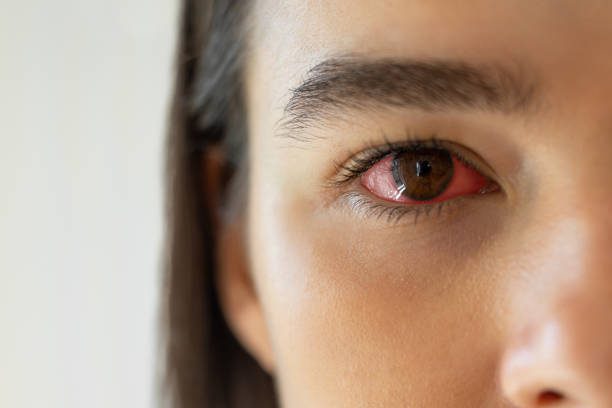⚠️ Medical Disclaimer
Important: This content is for informational and educational purposes only. It should not be used as a substitute for professional medical advice, diagnosis, or treatment. Always consult with a qualified healthcare provider before making changes to your diet, taking supplements, or if you have questions about a medical condition. Never disregard professional medical advice or delay seeking it because of information you read here.
Last Updated on January 18, 2024 by Grace Oluchi
Introduction.
Red eyes are a common condition that can be caused by a variety of factors, from allergies and infections to more serious eye conditions. While red eyes are often temporary and harmless, they can also be a sign of a more serious underlying condition. In this guide, we’ve compiled the top 5 frequently asked questions about red eyes, including their causes, complications, and more.
Red Eyes.
Red eyes, also known as bloodshot eyes, refer to the appearance of the eyes when the blood vessels in the eye become enlarged and dilated, causing the eye to appear red or pink. The redness of the eyes can range from a mild pinkish hue to a deep red color.
Red eyes are a common condition that can occur for a variety of reasons. One of the most common causes of red eyes is eye strain, which can occur when you spend too much time looking at a computer screen or other digital device, or when you read for extended periods without taking breaks. Other common causes of red eyes include allergies, dryness, and exposure to irritants such as smoke or pollution.
In some cases, red eyes may be a symptom of an underlying medical condition, such as conjunctivitis, also known as pink eye, glaucoma, uveitis, and corneal ulcers. These conditions require medical attention to treat the underlying cause of the redness.
Treatment for red eyes depends on the underlying cause. If the redness is due to eye strain, taking frequent breaks from digital devices and practicing good eye hygiene can help alleviate symptoms. Over-the-counter eye drops can also help to soothe dry, itchy eyes. If the redness is due to an infection or other medical condition, prescription eye drops, or other treatments may be necessary.
While red eyes are usually not serious, there are some cases where they can be a sign of a more serious condition. If you experience severe eye pain, vision changes, or other concerning symptoms, it’s important to seek medical attention right away.
Overall, red eyes can be uncomfortable and unsightly, but they are usually not a cause for alarm. By taking steps to reduce eye strain and practicing good eye hygiene, you can help prevent red eyes and keep your eyes healthy and comfortable.
Causes of Red Eyes.


Red eyes, also known as bloodshot eyes, can be caused by a variety of factors. Here are some of the most common causes of red eyes:
- Eye strain: One of the most common causes of red eyes is eye strain. This occurs when you spend too much time looking at a computer screen or other digital device, or when you read for extended periods without taking breaks.
- Allergies: Allergies can cause redness and itching of the eyes. Common allergens include pollen, dust, and pet dander.
- Dry eyes: When your eyes are not producing enough tears or when the quality of tears your eyes produce is poor, it can lead to dry, itchy, and red eyes.
- Irritants: Exposure to irritants such as smoke, pollution, or chemicals can cause redness and irritation of the eyes.
- Infections: Viral or bacterial infections can cause redness and inflammation of the eyes. Conjunctivitis, also known as pink eye, is a common infection that can cause red eyes.
- Contact lenses: Wearing contact lenses for extended periods or not cleaning them properly can cause redness and irritation of the eyes.
- Injuries: Trauma to the eye, such as a scratch or foreign object in the eye, can cause redness and irritation.
- Medical conditions: Certain medical conditions, such as glaucoma, uveitis, and corneal ulcers, can cause redness and inflammation of the eyes.
While red eyes are usually not serious, there are some cases where they can be a sign of a more serious condition. If you experience severe eye pain, vision changes, or other concerning symptoms, it’s important to seek medical attention right away.
Treatment for Red Eyes.
The treatment for eye redness depends on the underlying cause. Here are some common treatments for different causes of eye redness:
- Eye strain: To treat eye strain that causes redness, take frequent breaks from digital devices and reading. The 20-20-20 rule is recommended, which is to take a break every 20 minutes and look at something 20 feet away for 20 seconds. Over-the-counter eye drops can also help relieve dry, itchy eyes.
- Allergies: To treat red eyes caused by allergies, avoid allergens when possible and use over-the-counter antihistamine eye drops or oral medications. Cold compresses can also help reduce inflammation.
- Dry eyes: To treat red eyes caused by dryness, use artificial tears or other lubricating eye drops to keep the eyes moist. If the dryness persists, prescription eye drops or other medications may be necessary.
- Irritants: To treat red eyes caused by irritants, avoid exposure to the irritant and use over-the-counter eye drops to soothe the eyes. Cold compresses can also help reduce inflammation.
- Infections: To treat red eyes caused by infections, prescription eye drops or other medications may be necessary.
- Contact lenses: To treat red eyes caused by contact lenses, remove the contacts and use eye drops to soothe the eyes. If the redness persists, it may be necessary to switch to a different type of contact lens or use a different cleaning solution.
- Injuries: To treat red eyes caused by injuries, seek medical attention right away. Treatment may include eye drops, antibiotics, or other medications as needed.
It’s important to note that while over-the-counter eye drops can be helpful for some causes of eye redness, they should not be used excessively as they can actually worsen dryness or irritation if overused. If your symptoms do not improve with at-home treatment or if you experience severe eye pain, vision changes, or other concerning symptoms, it’s important to seek medical attention right away.
You May Also Read
- Stye (Sty): What it is, Causes, Treatments and more
- Collagen: What it is, Health Benefits, Types and More.
- Razor burn: Causes, Treatment and More.
- Razor burn: Causes, Treatment and More.
- Untangling Diabetes: Your Comprehensive Guide
Complications.
Eye redness can be a symptom of a variety of conditions, some of which can lead to complications if not treated promptly. Here are some potential complications of eye redness:
- Vision loss: Eye redness can be a symptom of conditions that can cause vision loss, such as glaucoma or uveitis. If left untreated, these conditions can lead to permanent vision loss.
- Corneal damage: Eye redness can be a symptom of corneal ulcers, which are open sores on the cornea that can cause scarring and vision loss if not treated promptly.
- Infections: Eye redness can be a symptom of infections such as conjunctivitis or keratitis. If left untreated, these infections can spread and cause more serious complications.
- Systemic diseases: Eye redness can be a symptom of systemic diseases such as lupus or rheumatoid arthritis. If left untreated, these conditions can cause other health problems.
When to Contact a doctor?
It’s important to contact a doctor if you experience any of the following symptoms:
- Severe eye pain.
- Vision changes.
- Eye discharge.
- Sensitivity to light.
- Swelling around the eye.
- A foreign object in the eye.
- Symptoms that persist despite at-home treatment.
If you have a known eye condition or are at higher risk for certain eye diseases, such as glaucoma, it’s important to have regular eye exams to detect any issues early and prevent complications. If you experience sudden or severe eye redness, it’s important to seek medical attention right away to determine the underlying cause and receive appropriate treatment.
Prevention of Red Eyes.
To prevent eye redness, follow these tips:
- Take frequent breaks from digital devices and reading and practice the 20-20-20 rule.
- Avoid exposure to allergens and irritants.
- Use lubricating eye drops to prevent dryness.
- Wear protective eyewear when necessary, such as when playing sports or working with chemicals.
- Practice good hygiene to prevent the spread of infections.
- Have regular eye exams to detect any issues early.
The Key Takeaway.
Eye redness can be a symptom of a variety of conditions, ranging from minor irritations to serious infections or diseases. While some cases of eye redness can be treated at home with over-the-counter remedies, it’s important to seek medical attention if symptoms persist or if you experience other concerning symptoms such as vision changes or severe eye pain. To prevent eye redness, practice good eye hygiene, avoid irritants, and have regular eye exams.
What are the common causes of red eyes?
Red eyes can be caused by a variety of factors, including allergies, dry eyes, eye infections, and eye injuries. Other factors such as excessive alcohol consumption, smoking, and lack of sleep can also cause red eyes.
Can red eyes be a sign of a more serious condition?
Yes, they can sometimes be a sign of a more serious underlying condition, such as glaucoma or uveitis. If red eyes are accompanied by other symptoms such as eye pain, sensitivity to light, or vision changes, it’s important to seek medical attention immediately.
What are the complications of untreated red eyes?
Complications of untreated red eyes can include vision loss, eye infections, and permanent damage to the eyes. It’s important to seek treatment if they persist or are accompanied by other symptoms.
How are red eyes treated?
Treatment for it depends on the underlying cause. In some cases, over-the-counter eye drops, or artificial tears can help alleviate symptoms. In more serious cases, prescription medications or surgery may be necessary.
How can I prevent red eyes?
Preventing it involves taking care of your overall health and protecting your eyes from injury or infection. This includes getting enough sleep, avoiding smoking and excessive alcohol consumption, wearing protective eyewear when necessary, and practicing good hygiene habits to prevent the spread of eye infections.

